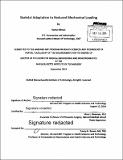Skeletal adaptation to reduced mechanical loading
Author(s)
Eliman, Rachel
DownloadFull printable version (18.06Mb)
Other Contributors
Harvard--MIT Program in Health Sciences and Technology.
Advisor
Mary L Bouxsein.
Terms of use
Metadata
Show full item recordAbstract
Bone adapts its mass and architecture in response to its mechanical environment. Yet control of this process by mechanical cues is poorly understood, particularly for unloading. Defining the fundamental mechanoregulation of bone adaptation is critical for the better understanding and mitigation of bone loss in astronauts as well as clinical conditions such as spinal cord injury, stroke, muscular dystrophy, and bed rest. The overall goal of this work was to study skeletal adaptation to varying amounts of reduced loading to help delineate the relationship between mechanical stimuli and skeletal adaptation. We first examined the relative contribution of muscle and gravitational forces to the maintenance of skeletal health in mice, using botulinum toxin (BTX) to induce muscle paralysis and hindlimb unloading to eliminate external loading on the hindlimbs, alone and in combination. BTX led to greater bone loss than hindlimb unloading, while the combination of interventions led to the most detrimental effects overall, suggesting that both muscle and gravitational forces play a role in skeletal maintenance, with greater contributions from muscle forces. We then characterized skeletal adaptation to controlled reductions in mechanical loading of varying degrees employing a novel model that enables long-term exposure of mice to partial weightbearing (PWB). We found that declines in bone mass and architecture were linearly related to the degree of unloading. Even mice bearing 70% of their body weight exhibited significant bone loss, suggesting that the gravity of the moon (0.16 G) and Mars (0.38 G) will not be sufficient to prevent bone loss on future exploration missions. Finally, since bone remodeling is highly site-specific, we used gait analysis and inverse dynamics to determine the mechanical environment during PWB, and then developed a finite element model of the tibia to resolve the local strain-related stimulus proposed to drive changes in bone mass. We found modest correlations between cortical bone architecture at different PWB levels and strain energy density. Altogether this work provides a critical foundation and rationale for future studies that incorporate detailed quantification of the mechanical stimuli and longitudinal changes in bone architecture to further advance our understanding of the skeletal response to reduced loading.
Description
Thesis: Ph. D., Harvard-MIT Program in Health Sciences and Technology, 2014. Cataloged from PDF version of thesis. Includes bibliographical references (pages 126-139).
Date issued
2014Department
Harvard University--MIT Division of Health Sciences and TechnologyPublisher
Massachusetts Institute of Technology
Keywords
Harvard--MIT Program in Health Sciences and Technology.